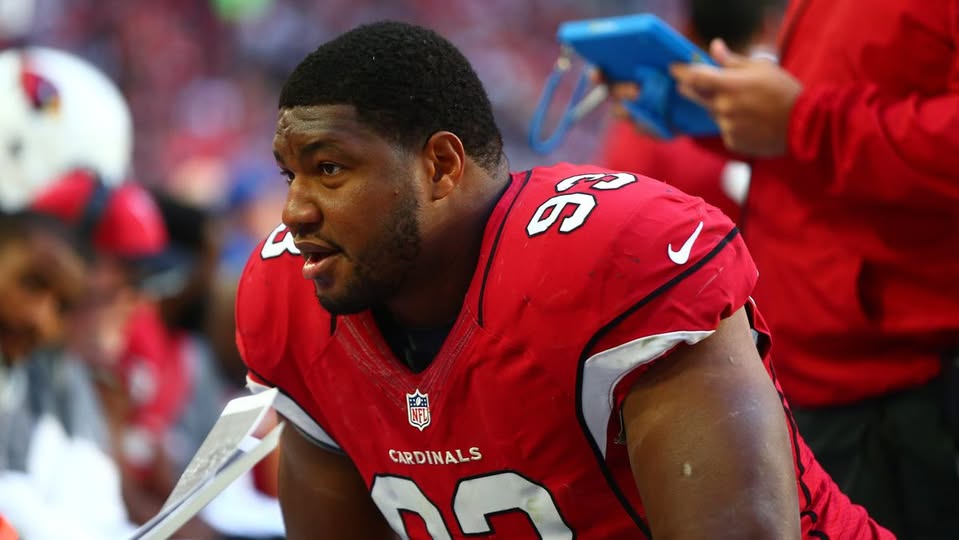When Calais Campbell signed with the Arizona Cardinals for what could be his final NFL season, it was more than just a homecoming. It was a full-circle moment for one of the most respected defensive linemen in the history of the franchise. On Thursday morning, the Cardinals made a symbolic and sentimental gesture that hit all the right notes for fans and players alike—Campbell will don No. 93 once again, the jersey number he wore during his first stint in Arizona from 2008 to 2016.
The announcement was accompanied by another layer of excitement, as the organization revealed subtle yet meaningful additions and updates to their uniform set heading into the 2025 season. While the Cardinals underwent a major uniform redesign ahead of the 2023 campaign, these latest tweaks are more about refining the look and enhancing the team’s connection to its legacy. The changes come at a time when the team is embracing its past, while still forging a bold path toward the future.
For Campbell, the return to Arizona is deeply personal. He spent the first nine years of his NFL career with the Cardinals after being drafted in the second round out of Miami in 2008. Over that span, he became a cornerstone of the team’s defense, earning two Pro Bowl selections and amassing 56.5 sacks, second-most in franchise history at the time of his departure. He was not just a dominant presence on the field but also a beloved leader in the locker room and the community. His return is a celebration of that legacy.
The decision to bring back Campbell and give him back his iconic No. 93 jersey carries emotional weight. During his time in Jacksonville, Baltimore, and Atlanta, Campbell wore different numbers, but No. 93 in a Cardinals uniform remains the image that resonates most with fans. The number had been worn by others in recent seasons, but the team made the classy decision to restore it to its rightful owner.
Campbell expressed his gratitude in a heartfelt message shared on social media shortly after the announcement: “No. 93 has always been a part of who I am. To wear it again in the place that shaped me into the man I am today is a blessing beyond words. Thank you to the Cardinals organization and to the fans who welcomed me back with open arms.”
The team followed up that post with a promotional video showcasing Campbell’s return, spliced with highlights from his first run with the team. It closed with a shot of his new locker at State Farm Stadium—nameplate emblazoned with “Campbell” and the familiar “93” jersey hanging proudly inside.
For Cardinals fans, especially those who’ve followed the team for decades, this is a full-circle moment worth savoring. Campbell was instrumental in Arizona’s run to the NFC Championship Game in 2015 and played a major role during the team’s most competitive years under head coach Bruce Arians. His presence now brings veteran leadership to a young and rebuilding defense, as well as a sense of continuity in a sport that so often feels transient and transactional.
Campbell’s return also dovetails with the Cardinals’ broader efforts to reinvigorate their identity through visual and cultural touchstones. When Arizona unveiled its new uniforms in 2023, the changes were met with mixed reactions. The redesign emphasized simplicity and modernity, with streamlined color patterns, a revamped font, and a bold “ARIZONA” wordmark across the chest. Gone were the elaborate piping and striping of previous versions—replaced by a minimalist aesthetic intended to reflect a no-nonsense attitude and a commitment to a new era.
But now, in 2025, the team is building on that foundation with several thoughtful additions and changes. First and foremost is the return of the black alternate helmet, a fan favorite that first debuted in limited games. Now part of the permanent rotation, the black helmet features a subtle red chrome outline around the cardinal logo, providing a sleeker, more aggressive look under the lights.
The team also announced the reintroduction of a “throwback” alternate uniform that pays homage to the 2008-2015 era—coinciding with Campbell’s original tenure. That uniform includes the red jersey with white sleeves, black trim, and traditional block numbering that defined the franchise during one of its most successful periods. Worn primarily for legacy games and special occasions, the throwback set will connect today’s roster with legends of the past such as Campbell, Larry Fitzgerald, Carson Palmer, and Patrick Peterson.
The current home and away uniforms are also getting slight adjustments. On the red home jersey, the sleeve pattern has been modified to include subtle feather detailing—a nod to the cardinal bird—and the updated collar now bears the Latin phrase “Virtus in Arduis,” which translates to “Strength in Adversity.” The phrase was selected by team leaders to reflect the culture head coach Jonathan Gannon and general manager Monti Ossenfort are striving to build: one rooted in grit, perseverance, and collective accountability.
The white road jersey, meanwhile, will now feature a red outline around the player numbers to improve visibility and balance the color scheme. In another symbolic change, the team is introducing a new patch to be worn on all jerseys this season—an interlocking “AZ” insignia designed by a local Navajo artist. The patch is part of the team’s broader outreach to honor and collaborate with the Native American communities that have shaped Arizona’s heritage.
Fan response to the changes has been largely positive, especially on social media platforms where images of the updated uniforms and Campbell’s new No. 93 jersey quickly went viral. “That’s how you honor a legend,” one fan wrote on X. “Welcome home, Calais. The red and white never looked better.” Another commented, “The little touches—the feathers, the AZ patch, the Latin motto—it’s all part of a bigger story. This feels like the Cardinals are finally telling our story.”
From a branding perspective, these updates signal a more intentional direction for the franchise. The Cardinals have long struggled with national relevance, often overshadowed by larger-market teams in the NFC. But moves like this—leaning into heritage, honoring icons like Campbell, and refining the visual identity—represent a strategic push to build a lasting and distinctive culture.
On the field, Campbell’s impact is expected to be both immediate and influential. Even at 38 years old, he remains a productive player, having recorded 6.5 sacks and 12 tackles for loss with the Falcons last season. His durability and leadership are virtually unmatched among current defensive linemen, and his mentorship could prove invaluable for young players like BJ Ojulari and Dante Stills.
Cardinals defensive coordinator Nick Rallis praised the acquisition, saying, “Calais is a tone-setter. He’s the kind of guy who elevates everyone around him, not just with his play but with his preparation and energy. We’re thrilled to have him back in the building.”
Campbell’s role won’t be limited to the locker room. The Cardinals plan to feature him in community events, team outreach programs, and alumni initiatives, reinforcing his role as a bridge between the organization’s past and its future. Sources close to the team indicate that Campbell may even transition into a front-office or advisory role upon his retirement, further deepening his ties to the franchise.
As for the broader fan base, Campbell’s return, paired with the uniform updates, has reignited excitement for the 2025 season in a way that few offseason moves could. Season ticket inquiries have reportedly spiked since the news broke, and the team is planning a special “Legends Weekend” in October, which will include a ceremony honoring Campbell’s contributions over the years.
It’s rare in sports to get a clean, full-circle narrative. Athletes move on, teams change direction, and sentimentality is often sacrificed at the altar of efficiency. But in bringing Calais Campbell back to Arizona, and giving him his beloved No. 93 once more, the Cardinals have done something that transcends stats and salary caps. They’ve reminded fans—and players—of what loyalty, legacy, and identity really mean.
In a league that often moves too fast to stop and appreciate the journey, Arizona has pressed pause long enough to give one of its greatest warriors a proper salute. And in doing so, they’ve given fans a reason to believe that even as the future looms large, the past still matters.



